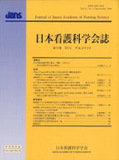Japanese
English
- 販売していません
- Abstract 文献概要
- 参考文献 Reference
- サイト内被引用 Cited by
要旨
感染症リスク認知の新しい試みとして,26のリスク事象(感染症13,その他13)に対するイメージ,および,知識度と清潔意識を調査し,恐ろしさ因子軸と未知性因子軸からなるリスク認知地図の作成を試みた.感染症の知識や体験のリスク認知への影響を明らかにするため,調査対象を次の5つの対象者グループとした.①集団感染症の体験と知識があるN病院看護師群51名,②集団感染症の体験があり知識のないS大学生群53名,③感染症の体験はなく知識があるK病院看護師群50名,④体験はないが若干の感染症の知識を有するK看護大学生群50名,⑤感染症の知識も体験もないF大学生・社会人群111名である.
その結果,13の感染症リスク項目は,感染症以外の13のリスク項目と分離することなく混在して付置していた.全般的に感染症の因子(リスク認知)得点の平均値が高かった対象者グループは,集団感染症の体験がある第②グループで,逆に全般的に平均値が低かったのは,集団感染症の体験と知識がある第①グループであった.
Abstract
For a new trial to risk cognition of infectious diseases, mental images, knowledge and awareness associated with 26risks (infectious diseases:13 items, and others:13 items) were first assessed, and a risk cognition map of infectious diseases, consisting of a fear-factor axis and an unknown-factor axis, was then trailed. In order to investigate the influences of knowledge and experience for infectious diseases on risk cognition, the subjects were in the following five groups:① 51nurses worked in the N hospital, who had knowledge and experiences of mass infection;② 53students belonged to the S university, who had experiences of mass infection; ③ 50nurses worked in K hospital, who had knowledge of mass infection;④ 50nursing students attended to K university, who had some knowledge of mass infection; and ⑤ 111F university students and adults who had no knowledge or experience of mass infection.
Copyright © 2004, Japan Academy of Nursing Science. All rights reserved.


